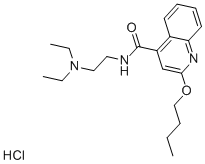61-12-1

Product Name:
Dibucaine hydrochloride
Formula:
C20H30ClN3O2
Synonyms:
2-Butoxy-N-(2-diethylaminoethyl)-4-quinolinecarboxamide hydrochloride;Cinchocaine hydrochloride;Dibucaine hydrochloride
Inquiry
CHEMICAL AND PHYSICAL PROPERTIES
| Solubility | >57 [ug/mL] (The mean of the results at pH 7.4) |
|---|---|
| Collision Cross Section | 195.5 Ų [M+H]+ [CCS Type: TW, Method: calibrated with polyalanine and drug standards] |
SAFETY INFORMATION
| Signal word | Danger |
|---|---|
| Pictogram(s) |
 Corrosion Corrosives GHS05  Exclamation Mark Irritant GHS07 |
| GHS Hazard Statements |
H302:Acute toxicity,oral H318:Serious eye damage/eye irritation |
| Precautionary Statement Codes |
P280:Wear protective gloves/protective clothing/eye protection/face protection. |
COMPUTED DESCRIPTORS
| Molecular Weight | 379.9 g/mol |
|---|---|
| Hydrogen Bond Donor Count | 2 |
| Hydrogen Bond Acceptor Count | 4 |
| Rotatable Bond Count | 10 |
| Exact Mass | 379.2026549 g/mol |
| Monoisotopic Mass | 379.2026549 g/mol |
| Topological Polar Surface Area | 54.5 Ų |
| Heavy Atom Count | 26 |
| Formal Charge | 0 |
| Complexity | 387 |
| Isotope Atom Count | 0 |
| Defined Atom Stereocenter Count | 0 |
| Undefined Atom Stereocenter Count | 0 |
| Defined Bond Stereocenter Count | 0 |
| Undefined Bond Stereocenter Count | 0 |
| Covalently-Bonded Unit Count | 2 |
| Compound Is Canonicalized | Yes |
PRODUCT INTRODUCTION
description
Dibucaine hydrochloride is used as an anaesthetic agent for spinal anaesthesia. More commonly it is a component in rectal medications used in inflammation of the anus and for the symptomatic treatment of haemorrhoids and fissures in the anus.
